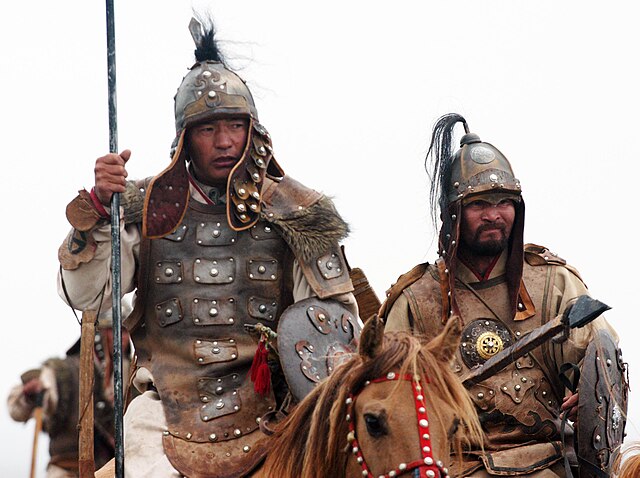
The Mongol Empire was the largest contiguous land empire in history. At its peak in the 13th century CE, it stretched from Eastern Europe to the Sea of Japan, covering over 33 million km2 of territory across Asia and parts of Europe. This dwarfed the estimated 5 million km2 conquered by the Roman Empire at its territorial height in the 2nd century CE. But how long did it actually take the Mongols to conquer more land area than imperial Rome?
Rise of the Mongol Empire
The Mongol Empire originated in the early 13th century when Genghis Khan united various nomadic tribes on the Mongolian plateau. Through a series of military campaigns, Genghis Khan rapidly expanded Mongol rule from its heartland to encompass much of continental Asia. This expansion continued after his death in 1227 under the leadership of his sons and grandsons.
By 1279, just 77 years after Genghis Khan began uniting the Mongol tribes, his grandson Kublai Khan had completed the conquest of the Song dynasty in southern China. With this final conquest, the Mongol Empire encompassed all of modern-day China as well as Mongolia, Korea, and regions of Central Asia, Iran, and southern Russia - far surpassing the territorial extent of the Roman Empire at any point in its history.
Comparing Mongol and Roman Territorial Extent
Sources vary on precisely how much land area was governed by the Roman and Mongol empires at their peaks. However, most estimates agree that imperial Rome controlled between 3.5 to 5 million km2 compared to over 33 million km2 for the Mongol Empire.
To put this vast difference in perspective:
- The Mongol Empire was over 6 times larger than the Roman Empire in terms of land area conquered
- It took the Romans over 700 years (27 BCE to 117 CE) to conquer the territories under its control, while the Mongol Empire gained its vast domains in just 77 years
- On average, the Mongols conquered over 429,000 km2 per year during their rapid expansion, compared to just 7,100 km2 per year for the Roman conquests
So while imperial Rome was certainly an formidable empire in the ancient world, the Mongols managed to subjugate a much larger swath of territory in a fraction of the time.
Factors Enabling Rapid Mongol Expansion
Several key factors came together to enable the Mongols’ exceptionally swift conquest of land area surpassing imperial Rome’s holdings:
Military Innovations
The Mongols had several military advantages stemming from their nomadic lifestyle and expertise with horses:
- Superior mobility - All Mongol warriors were highly skilled horsemen, allowing their armies to outmaneuver opponents
- Compound bows - Devastating weapon with superior range and power compared to mainland Asian bows
- Coordination and discipline - Forces could efficiently relay messages and orders over vast distances
Furthermore, the Mongols were brilliant at adapting and improving military technologies like siege engines and gunpowder weapons gained from conquered peoples. This combination of nomadic cavalry and advanced siege craft led them to overwhelm one city/state after another.
Political Organization
Genghis Khan revolutionized steppe political organization by instituting a unified command and loyalty-based promotion system. This resulted in:
- United leadership - All Mongol forces centrally coordinated by the Great Khan
- Meritocracy - Generals promoted on basis of ability, not bloodlines
- Smoother transitions - Clear succession structure ensuring continuity between Khans
As such, upon each Khan’s death, Mongol expansion proceeded seamlessly as the next leader wielded centralized control over the entire imperial army.
Psychological Warfare
The Mongols deliberately spread terrifying tales of destruction to break the resistance of towns and cities in their crosshairs. If a city surrendered promptly, its residents would generally be spared - incentivizing quick capitulation. Cities that resisted, however, would be utterly obliterated. As tales of flattened cities spread, other regions preemptively submitted to Mongol rule.
This combination of enticements toward submission and horrifying punishment of resistance minimized Mongol losses in battle while accelerating the pace of conquest.

Reasons for the Mongols’ Vast and Rapid Conquests
In essence, the Mongols expanded so astonishingly quickly because:
- They held major military advantages stemming from horsemanship prowess, coordination over vast distances, and adoption of advanced weapons/technologies
- Political organization changes enabled continuity of leadership and strategy between Khans
- Psychological tactics minimized losses from battles while accelerating surrender of new territories
These interlinking factors catalyzed the drastic outmatching of Rome’s centuries-spanning conquests within just over seven decades on the Mongol warpath.
So in just 77 years, the nomadic horsemen of the steppes established undisputed dominance over every major Old World civilization - from the rice paddies of China to the forested frontier of Eastern Europe. By rapidly adapting new military innovations while instituting organizational reforms, the Mongols conquered over 6 times more territory each year than the Roman legions at their peak. Truly stunning historical progress measured not in centuries, but decades.
Sources
-
Allsen, Thomas T. “The Rise of the Mongolian Empire and Mongolian Rule in North China.” In The Cambridge History of China: Alien Regimes and Border States, 907–1368, edited by Herbert Franke and Denis Twitchett, Cambridge University Press, 1994.
-
Di Cosmo, Nicola, Frank Tikhonov, and Peter B. Golden, eds. The Cambridge History of the Mongol Empire. Cambridge University Press, 2021.
-
“An Empire’s Epitaph: The Limits of the Mongol Empire.” Khan Academy, 2023, Accessed 10 February 2023.
-
Millward, James A. “The Mongol Empire (1206–1368) and Pax Mongolica.” In The Oxford Illustrated History of the World, edited by Felipe Fernández‐Armesto, Oxford University Press, 2020.